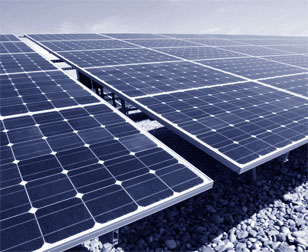24/7 solar energy
 There really is nothing like solar energy. The sun (or rather
sunshine) has enough and more energy to power the Earth (our cities and
our homes) till the end of the solar system. However, we do not yet have
the technology needed to fully utilise this free and renewable source of
energy. Most solar panels that you see on rooftops and even solar power
installations can manage only around 20 percent efficiency. There really is nothing like solar energy. The sun (or rather
sunshine) has enough and more energy to power the Earth (our cities and
our homes) till the end of the solar system. However, we do not yet have
the technology needed to fully utilise this free and renewable source of
energy. Most solar panels that you see on rooftops and even solar power
installations can manage only around 20 percent efficiency.
There is also the whole question of tapping into solar energy at
night. It is possible to ‘store’ solar energy via batteries, but again,
the efficiency level is minimal. Moreover, devices that require ‘direct’
solar energy cannot be operated at night.
Achieving round-the-clock solar energy utilisation will be a major
breakthrough. Scientists have now built a system that converts Sun's
energy into hydrogen fuel during the day and stores it for later use,
allowing people to power their devices even at night. Researchers led by
Tom Meyer at the Energy Frontier Research Center at the University of
North Carolina at Chapel Hill, USA, have built the system that converts
the Sun's energy into hydrogen fuel and stores it for later
use. Hydrogen itself is often described as a “fuel of the future” that
could power everything from cars to homes.
In fact, the first-mass produced hydrogen fuel-cell powered vehicles
would be on the road by end 2015. Scientists involved in the project say
so-called ‘solar fuels’ like hydrogen offer a solution on how to store
energy for night-time use by taking a cue from natural photosynthesis
through which plants obtain energy and sustain themselves.
The new system designed by Meyer and colleagues at UNC and with Greg
Parsons’ group at North Carolina State is known as a dye-sensitised
photoelectrosynthesis cell, or DSPEC. It generates hydrogen fuel by
using the Sun's energy to split water into its component parts. After
the split, hydrogen is sequestered and stored, while the by-product,
oxygen, is released into the air. It was notoriously difficult to
achieve this process until now, but Meyer and his team have apparently
overcome such hurdles. However, they will have to do much more work in
the coming years to perfect the technology.
Commercialisation
The benefits of this move are enormous. While commercialisation of
this new technology could be some years away, more households could be
encouraged to switch to solar if devices can be powered from the sun
even at night. After all, everyone likes to get electricity for free and
once set up, solar energy is virtually free for life, apart from minimal
maintenance costs for the panel itself.
 Having said that, initial costs for this technology, once perfected,
could be rather high. Governments will have to grant concessions to
those who opt for such advanced solar technologies (Most Governments
already do). Having said that, initial costs for this technology, once perfected,
could be rather high. Governments will have to grant concessions to
those who opt for such advanced solar technologies (Most Governments
already do).
This could be the only way to electrify certain remote villages which
the national grid cannot reach due to geographical or other constraints.
Attitudes have to change - while the authorities do strive to take the
mains grid to all corners of the island, it might simply be not viable
to extend it to very remote villages. Any excess electricity generated
by solar households can be sold back to the national grid, as is already
done.
Solar, along with wind, is an energy source of the future that is
available right now. Nevertheless, there should be a quantum leap in
technology and pricing before solar (and wind) can achieve universal
penetration.
Developing countries, especially tropical ones such as Sri Lanka with
abundant sunshine, can benefit more from this kind of technology.
It is also heartening to note that more private companies are forming
partnerships for popularising solar. At least one private bank in Sri
Lanka offers loans for installing solar panels at your home for powering
the light bulbs and other devices (not hot water projects).
The panels have to be sourced from reputed solar vendors named by the
bank. This is a win-win situation for all three parties - bank, vendor
and end user.
The savings accrued from using a solar system at home can rapidly
offset the loan amount (within three to five years), making it a
worthwhile long-term investment. More commercial establishments too
should consider taking the solar route because the savings could be
massive in the long term.
Slowdown
There has been a slowdown in the construction of major solar plants
worldwide, but more efficient panels and harnessing technologies could
turn the tide once more. Thinking outside the box is very important here
- we tend to think that rooftop panels are always required, but what
about windows and other structures that can supply solar power far more
unobtrusively?
In fact, new solar cells embedded in glass can do wonders for a
building or even a home.
Thin films are sprayed onto glass, and within those films, tiny
functional organic solar cells (about one-fourth the size of a grain of
rice) collect light from the sun and even from light bulbs which is then
converted into electricity.
They also have the extra benefit of allowing/utilising natural
daylight (and passive solar heating in cold climes), which cuts down
main-line on electricity use as well. Instead of installing separate
solar panels, window solar cells can be installed just like conventional
windows with a small additional cost. There are even spherical solar
cells which can be placed anywhere to generate electricity.
In the future, solar electricity will not be static. Our movements
too will be powered by the sun. One example is the recently unveiled
Ford C-MAX Energi concept car which has a solar roof that can actually
track the sun to get optimal power. Expect more solar cars in the next
decade.
There will be plenty of improvements in the solar energy sector
during that time frame, including energy storage solutions. Solar
energy, along with wind and nuclear fusion, has the potential to light
up our world - and our lives - without causing any damage to the
environment.
It is a clean source of energy that should get more traction in the
years ahead. |

